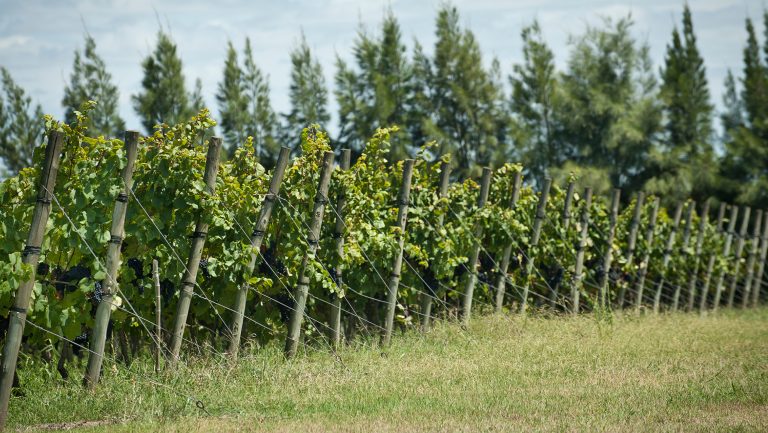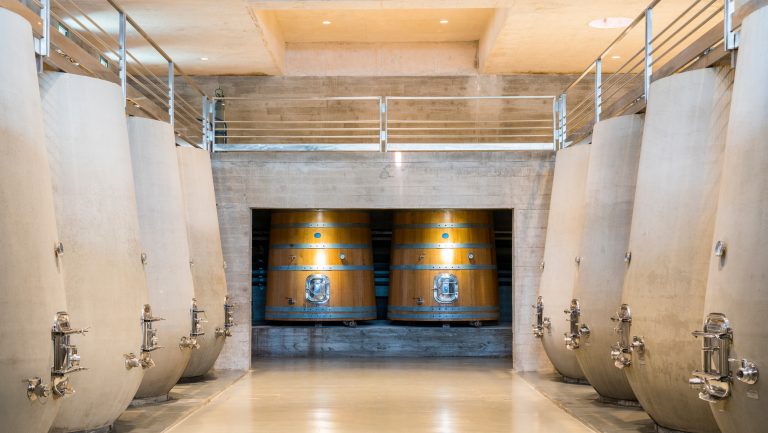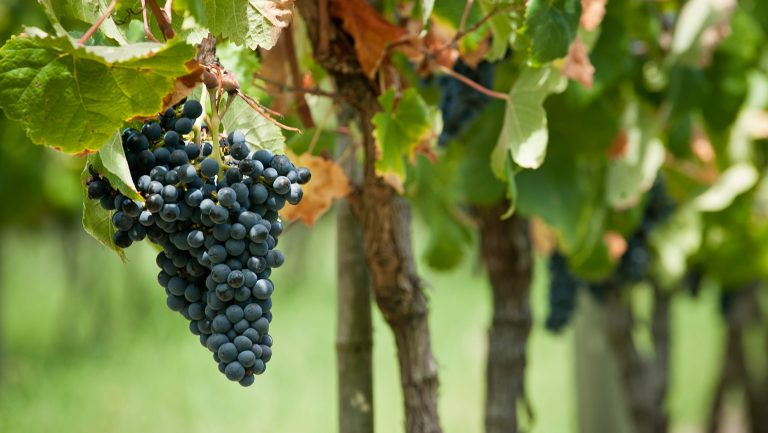Nestled between Argentina and Brazil, Uruguay is the fourth-largest wine producer in South America—its output in 2018 was 18 million liters. Although the bonds of tango and carnival link it culturally to Argentina and Brazil, respectively, the wine production of Uruguay is unique on the continent.
Shaped by a mild, Atlantic climate, Uruguay is more comparable to European wine regions than its Latin American neighbors, which have continental, Pacific, or subtropical influences.
“Uruguay reminds me more of Portugal—a small place with a maritime climate on the Atlantic Ocean, with variable weather,” says Hans Vinding Diers, who is a consultant winemaker at Bodega Oceánica José Ignacio in Maldonado, and has made wine on four continents. “You can also compare Uruguay to Bordeaux, as it has the same Atlantic influence.”

Don’t miss the latest drinks industry news and insights. Sign up for our award-winning newsletters and get insider intel, resources, and trends delivered to your inbox every week.
This Old World climate in the New World is part of the reason buyers are getting excited about Uruguayan wine; there’s also the thrill of discovering something new. “What we love about Uruguayan wine is its potential to become a major player in the South America wine map,” says Julio Robledo, a co-owner of Grand Cata, a wine store in Washington, D.C., that specializes in Latin American producers. “There is still much to see and discover from Uruguay, and diversity is the key. Many of our customers have a certain idea about Uruguay and Tannat, but when they taste a new bottle or a new grape from Uruguay, they definitely feel surprised by the quality.”
The eagerness for discovering unique and small-production wine regions is opening new opportunities for Uruguayan wine, which is now being exported to 51 countries. “It’s a good moment for Uruguayan wine because people are exploring and open to trying new regions—millennials want to understand terroir and a concept of place,” says the California-based winemaker Paul Hobbs, who makes wine in Uruguay with Familia Deicas and also imports the wines to the U.S. “I think there’s going to be a growth curve for Uruguay, and I believe Uruguay will be able to place itself as one of the smaller but great wine producers in the world.”

Key Wine Regions in Uruguay
Uruguay, which is 456 km long and 505 km wide, is similar in size to Washington State and has vineyards planted in every province. Vineyards are mainly concentrated, though, along the coastline—from the western river banks of Carmelo that face Buenos Aires in Argentina, right across to the popular surfing spots of the eastern coast, bordering Brazil. Although the heartland of wine production is the central coastal region of Canelones, all areas of Uruguay are being explored as winemakers seek out different profiles from the country’s 99 classified soil types and its many different microclimates.
Canelones
Almost in the middle of the coastline, Canelones is home to two-thirds of the country’s producers—most of whose holdings are family run and boutique in size. With a mild Atlantic climate and rolling hillsides, Canelones offers refreshing coastal breezes and fertile clay soils suited for wine production. The area’s main advantage over the last century, though, has been its proximity to the market—it’s right on the doorstep of the capital of Montevideo, where more than a third of the country’s population resides.
Although Tannat dominates, a wide range of grape varieties are planted in Canelones, ranging from Nero d’Avola to Pinot Noir, and the large variety of wine styles reflect the different personal tastes of Uruguay’s wine families. “Our wines are firstly Pisano and then Uruguayan,” says Daniel Pisano, whose family winery in Canelones exports 60,000 liters of wine a year to the U.S. with Total Wine, a wine retail chain based in Bethesda, Maryland. “Our wines are a family experience. Every wine from every family in Uruguay is different.”
Maldonado
The up-and-coming region of Uruguay is the cooler coastal region of Maldonado. Pioneered in 2001 by Alto de la Ballena, Maldonado has experienced fast growth; more than a dozen producers are located there today, drawn to the poorer, rocky soils and cooler temperatures that are suitable for a wide range of red and white varieties.

A wine route of producers has developed in Maldonado—they can all easily be visited on a day trip from the popular beach resorts of José Ignacio and Punta del Este. The biggest producer in Maldonado, and one of Uruguay’s leading exporters in value (exporting over 250,000 liters annually to the U.S.), is Bodega Garzón, founded by Argentine billionaire Alejandro Bulgheroni, who has invested over $1 billion over the last decade in wine estates across four continents. Garzón was crowned New World Winery of the Year 2018 by the Wine Enthusiast. “Although we are a New World wine region, the wines taste more European because of our humid, Atlantic terroir, with the mineral character of the granite soils,” says Christian Wylie, Garzón’s general manager. “Our different slope exposures and the cooler coastal breezes here [in Maldonado] mean we can grow many different varieties with great varietal typicity.”
Colonia
One of the more historic wine regions of Uruguay, Colonia is in the southwestern corner of the country, on the banks of the Rio de la Plata. Milder climatic conditions combine with sand, gravel, and calcareous soils to produce gentle, aromatic wines in both red and white varieties. Particularly of note are the wines from Carmelo, which is also a popular weekend getaway for well-heeled porteños from Buenos Aires.
Other Regions
Additional vineyards and producers worth exploring along the coast are located in San José, particularly the schist outcrop of Sierra de Mahoma; Montevideo, especially in the breezier region of Atlantida; and a handful of new vineyards in the easternmost coastal region of Rocha.
Inland, there are several subregions, the most notable being the central region of Durazno and the northern region of Rivera, bordering Brazil. These inland regions are generally slightly warmer and are known for their riper Tannats (producing wines more approachable in their youth) and fruit-forward white wines.

Getting to Know Uruguay’s Key Grape Varieties
Numerous grape varieties are planted in Uruguay, and they often reflect the various wine heritages of the producers. Take, for example, Pablo Fallabrino from Viñedo de los Vientos—he pays homage to his ancestors from Piedmont with Nebbiolo and Arneis—or Artesana, owned by a Californian, which planted Uruguay’s first Zinfandel. But the key grapes making award-worthy wines are Tannat and Albariño.
Tannat: An Established Champion
With more of this grape grown in Uruguay than anywhere else in the world, Tannat is the country’s champion variety, representing over a quarter of its production. Because it’s one of the most tannic varieties in the world, you might ask why it became Uruguay’s champion variety. “We didn’t choose Tannat as such—it chose us!” says third-generation vigneron Reinaldo de Lucca. “Every vintage, it performs very well, with great color, tannin, and acidity.”
Because of its coastal position, Uruguay has significant vintage variation, and the thick skins of Tannat are capable of withstanding wetter, drier, hotter, or cooler vintages and yielding dependable results. Moreover, Uruguay now has more than 100 years of experience with the variety, and this expertise is driving producers to experiment with a range of styles, from unoaked Tannat to sparkling (red) Tannat.
Winemakers are also using the variety as a vehicle to express their different terroirs. “Tannat can give you such different expressions,” says winemaker Santiago Deicas, who, with Familia Deicas, makes several single-vineyard Tannat wines from throughout Uruguay—“from our limestone vineyards,” he says, “which offer red fruit, elegance, and vibrancy … to volcanic rock, where we get juicy fruit and a very distinctive malted barley aroma!”
With its increasing diversity and quality, Uruguayan Tannat has never been a more exciting discovery.
Albariño: A Rising Star
Albariño is currently a rising star in Uruguay. Considering the country’s maritime climate, which is similar to that of Galicia and northern Portugal, it’s no surprise that it thrives here. But it wasn’t until recently that Albariño was first planted in Uruguay—by the Bouza family in their Canelones vineyard in the early 2000s.
The wine was a runaway success, and the family soon planted more Albariño, this time farther along the coast, in Pan de Azucar; other coastal producers followed suit, making Albariño one of the fastest-growing varieties in Uruguay at the moment. “There’s great potential with Uruguay’s Albariño,” says Spanish wine critic Pedro Ballesteros Torres, MW. “Uruguay is producing Albariño wines with lovely mineral expressions that are very precise and defined.”

Dispatch
Sign up for our award-winning newsletter
Don’t miss the latest drinks industry news and insights—delivered to your inbox every week.
Amanda Barnes is a British wine writer who since 2009 has been based in South America, where she specializes in the wines and regions of Argentina, Chile, Brazil, and Uruguay and writes the South America Wine Guide. Ever footloose, she is currently on a mission to travel Around the World in 80 Harvests.







